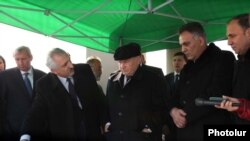It emerged that the authorities plan to build an upscale residential and financial district in place of a rundown neighborhood perched on a hill just outside the city center. Armenian officials spoke of billions of dollars needed for making those plans a reality.
Possible Russian involvement in the extremely ambitious project appeared to have dominated Luzhkov’s talks with Yerevan Mayor Gagik Beglarian. The two men headed to the Noragyugh neighborhood covering about 200 hectares of land after the talks.
“These proposals are very impressive. In the event of their implementation, a wonderful residential, business and cultural neighborhood will emerge in this location,” Luzhkov told journalists after inspecting the site and familiarizing himself with the architectural design of the buildings that would replace Noragyugh’s mostly ramshackle houses.
Luzhkov, who has presided over a massive post-Soviet construction boom in Moscow, said one of his deputies will visit Yerevan with a group of Russian investors in mid-March for more detailed talks with Armenian officials. “I think they will find interesting solutions and interesting proposals on the construction,” he said.
“The place is good, the project is very reasonable and good … We will therefore pay quite serious attention to this project,” added the influential mayor.
Luzhkov, whose wife reportedly owns one of Russia’s largest construction companies, was already prepared to estimate the approximate costs involved. “Freeing up this hill and resettling people will cost more than $100 million, and every building to be constructed there, if it is going to be big, will cost from $40 million to $60 million,” he said. “I think at least 50 such structures should be built in this place.”
Yerevan’s chief architect, Samvel Danielian, came up with an even more whopping estimate: at least $6 billion. The figure is equivalent to more than two-thirds of Armenia’s Gross Domestic Product in 2009.
“We plan to build here Yerevan’s new international center,” Danielian told journalists. “There will be a cultural section, a business section. The main foreign embassies will be represented here with their cultural missions. There will also be residential construction.”
Danielian added that the municipal authorities are already making plans for relocating some 1,500 families presently living in Noragyugh. All of them are to be resettled in new apartment blocks elsewhere in Yerevan, he said.
“We will do everything to make sure that the residents relocate with joy,” said Beglarian. “Remember this.”
The Armenian capital and especially its center have already undergone considerable redevelopment over the past decade. The process has been marred by forcible expulsions of hundreds of families unhappy with what they saw as meager government compensations for their properties.
The construction boom, fuelled by soaring real estate prices, was a major driving force behind Armenia’s double-digit economic growth that came to an end in late 2008. The Armenian construction sector has been hit particularly hard by the ensuing recession, contracting by over 36 percent in 2009. Many of the luxury apartments build in recent years have yet to find buyers.





